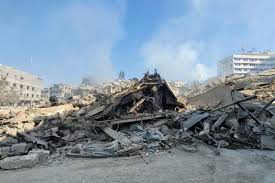In a dramatic escalation of regional tensions, Israeli airstrikes targeted multiple locations in southern Lebanon early Sunday morning, causing widespread destruction and reigniting fears of a broader conflict. The pre-dawn attacks, which included the demolition of a historic mosque and residential buildings, mark a significant intensification of the ongoing hostilities between Israel and Hezbollah. As the Middle East teeters on the brink of a potential regional war, these Israeli airstrikes underscore the volatile nature of the situation and the urgent need for diplomatic intervention.
Destruction of Cultural Heritage and Civilian Infrastructure
The Israeli airstrikes inflicted severe damage on both cultural and civilian targets in southern Lebanon:
1. At approximately 3:45 a.m., an airstrike completely destroyed the historic old mosque in the center of Kfar Tibnit, erasing a significant piece of cultural heritage.
2. Earlier, around 12:15 a.m., another strike leveled a three-story residential building next to Ghabris station on the Zefta-Nabatieh highway. This building had previously been partially damaged in an air raid just a week prior.
3. A third airstrike targeted the town of Aita al-Shaab at approximately 1:30 a.m., though details on the extent of damage or potential casualties were not immediately available.
These attacks on civilian infrastructure and cultural sites raise serious concerns about the nature of the targets being selected and the potential violations of international humanitarian law.
Hezbollah’s Response and Escalating Tensions
In the wake of the Israeli airstrikes, Hezbollah announced a series of retaliatory actions:
1. The group claimed to have successfully thwarted an Israeli infiltration attempt in the town of Ramiya, located in Lebanon’s Nabatieh Governorate. Hezbollah stated that its fighters detonated an explosive device against an Israeli force attempting to infiltrate the Tel al-Mador area at 4:45 a.m. on Sunday, reportedly inflicting casualties.
2. Hezbollah also reported targeting Israeli military positions and soldiers in northern Israel on Saturday night and Sunday morning. These strikes included attacks on Israeli military sites in Zarit, Shumra, and Ma’iliya, as well as in the Upper Galilee, using artillery and missile barrages.
3. The Israeli army claimed to have intercepted five rockets launched from Lebanon toward northern Israel, including the Haifa Bay area and the Upper and Western Galilee. Israeli media reported that at least 10 rockets were launched towards Haifa, with most intercepted and no injuries reported.
These exchanges highlight the rapid escalation of hostilities and the potential for the conflict to spiral out of control.
Broader Context and Humanitarian Impact of Israeli Airstrikes
The recent Israeli airstrikes and Hezbollah’s responses are part of a larger pattern of escalating violence in the region:
1. Israel has been conducting massive airstrikes across Lebanon against what it claims are Hezbollah targets since September 23. This campaign has resulted in at least 1,437 deaths, over 4,123 injuries, and the displacement of more than 1.34 million people.
2. The current situation is an escalation of a year-long cross-border warfare between Israel and Hezbollah, which intensified following Israel’s offensive on the Gaza Strip. In Gaza, Israeli actions have reportedly led to nearly 42,200 deaths, primarily women and children, since a Hamas attack last year.
3. Despite international warnings about the risk of a regional war, Israel expanded the conflict on October 1 by launching a ground incursion into southern Lebanon.
The humanitarian impact of this escalating conflict is severe, with civilian populations on both sides bearing the brunt of the violence. The destruction of homes, cultural sites, and critical infrastructure exacerbates the suffering and displacement of local communities.
The ongoing conflict raises several critical concerns:
1. The targeting of civilian infrastructure and cultural heritage sites may constitute violations of international law and could be considered war crimes.
2. The risk of the conflict spreading to other parts of the region remains high, with potential implications for regional stability and global security.
3. The humanitarian crisis continues to worsen, with increasing numbers of casualties and displaced persons requiring urgent international assistance.
4. The destruction of cultural heritage sites, such as the historic mosque in Kfar Tibnit, represents an irreplaceable loss to the region’s rich cultural tapestry.
As tensions continue to escalate, the international community faces mounting pressure to intervene and broker a ceasefire. The complex web of regional alliances and historical grievances makes finding a lasting solution challenging, but the urgency of the situation demands immediate action to prevent further loss of life and destruction.
The recent Israeli airstrikes on southern Lebanon mark a dangerous escalation in the ongoing conflict between Israel and Hezbollah. As both sides continue to exchange fire and expand their military operations, the risk of a wider regional war looms large. The destruction of civilian infrastructure and cultural heritage sites underscores the devastating impact of this conflict on local communities and the urgent need for a diplomatic resolution. Without swift intervention, the situation threatens to spiral into a catastrophic regional conflagration with far-reaching consequences for global stability.
Related News
















